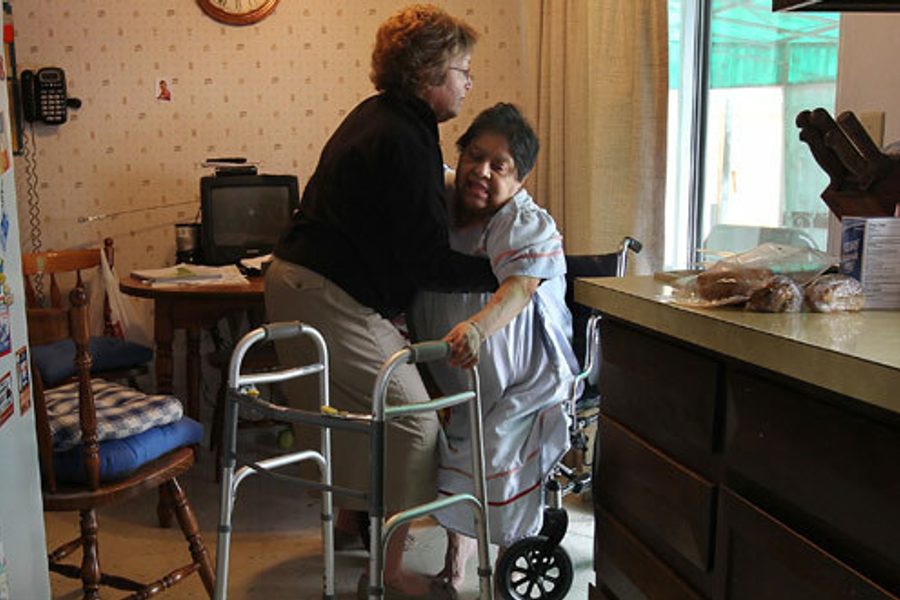
Two million American workers take care of other people with infirmities — frailties of old age, disabilities from injury or illness and other limitations that decades ago might have put them in an institution. But now many more of them are likely to be tended at home, and home care givers make up one of the fastest growing occupations in the country. Caregivers have long worked in limbo, however, with their rights ill-defined, their pay low, their industry in flux and their work underappreciated.
A District of Columbia Appellate Court took one big legal step towards improving the lot of home care workers on August 21 by upholding a decision by the Department of Labor that home care workers employed by third-party providers, whether public, non-profit or for-profit, are covered under federal wage and overtime rules.
When Congress modernized the Fair Labor Standards Act in 1974, which first regulated many dimensions of work such as minimum wages and overtime eligibility in 1938, it decided to cover “domestic service” workers for the first time. (Many African Americans had traditionally worked as domestic servants, especially in the South, and barring legal protections at work for them as well as for black agricultural workers was the price for racist Southern Democratic support of some New Deal labor advances.) But there was an exemption made to exclude domestic workers who provided “companionship” or who resided in the home. At the time, family members or “elderly sitters” performed a large part of domestic care work. Still, for the first time, the Department of Labor was given authority to define rules for this work more precisely.
Since the mid-1970s, the industry has grown dramatically, but will soon grow even faster, with a projected 1.3 million additional jobs over the next decade — “the fastest growing of employment of all industries, one of the largest increases in employment, and one of the fastest growing real outputs,” according to the Bureau of Labor Statistics.
The industry has also changed: more people with disabilities or need for regular care stay at home rather than living in an institution, as a matter of personal choice and public policy. As the population ages, their numbers and share of the population grow (from 10 percent of the population over 65 in 1970 to a projected 20 percent by 2030). The caregivers are now mainly supplied by national and regional providers, not “mom and pop” operations — and funding comes from personal and public sources. The caregivers need — and often have — a broader range of skills and training to do their work.
But conditions in the business discourage caregivers, roughly 90 percent of whom are women and more than half women of color, from maintaining a steady career. Turnover rates (between 44 and 65 percent a year, according to the Paraprofessional Health Care Institute, or PHI), vacancies and shortages are high — and often costly, at least $2,500 per turnover, according to a PHI study. And such instability lowers the quality of care. The discontent partly reflects the lack of rights and low pay — median pay in the industry was $9.40 an hour in 2010, nearly $7 below the national median pay, according to PHI. Nearly 60 percent of workers have only part-time hours at some point each year.
With clearly established rights to a federal minimum wage (and a likelihood they would then be covered by many localities or states with minimums above the federal level), pay could increase for many home care workers. But only about 10 percent report working overtime, making that benefit presently a bit less valuable.
If PHI studies of the 15 states that already guarantee minimum wage and overtime protection to home care workers offer a guide, however, the people given care benefit as much as the caregivers from better pay and working conditions. And as the quality of care rises, the agencies continue to grow and profit.
The appeals court decision, which overturned a district court’s ruling that the Department of Labor stepped out of bounds with its new rule, technically only applied to the District of Columbia, but advocates for home care workers think the issue of the legal status of home care workers is now settled.
After the decision was announced, Christine Owens, executive director of the nonprofit research and advocacy group, National Employment Law Project, joined other “friends of the court” on the side of the caregivers in celebrating. “It’s an exciting day and welcome news for 2 million home care workers who are one step closer to having their federal minimum wage and overtime pay protection guaranteed,” she said. “The impact is just enormous.”
David Moberg, a former senior editor of In These Times, was on staff with the magazine from when it began publishing in 1976 until his passing in July 2022. Before joining In These Times, he completed his work for a Ph.D. in anthropology at the University of Chicago and worked for Newsweek. He received fellowships from the John D. and Catherine T. MacArthur Foundation and the Nation Institute for research on the new global economy.








